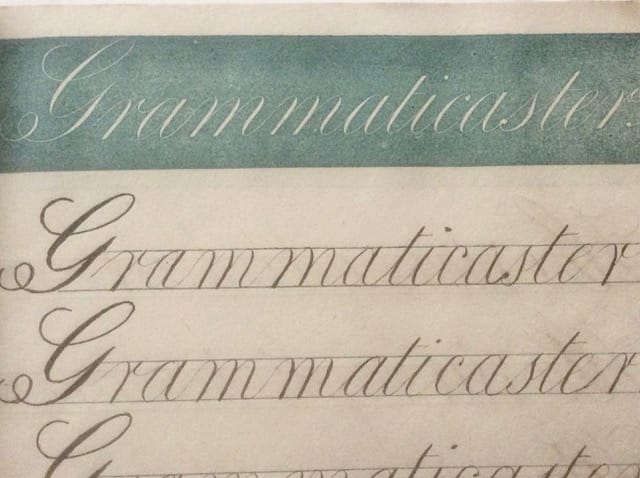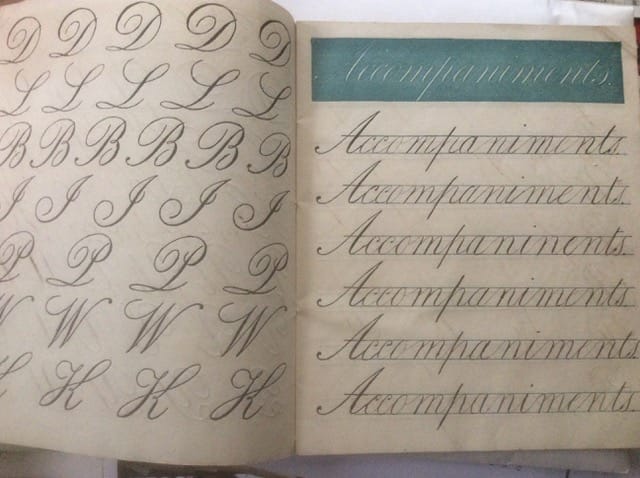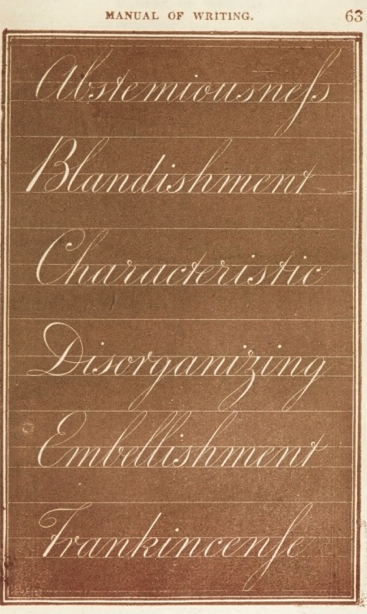Negative pedagogy
I don't mean to suggest that teachers engaged in punishment to improve their student's penmanship; rather that some writing masters cut the letters into a wooden block. By doing so, the student could easily trace over the negative letter, and see how well they filled in the letterform. While there have been many instances of a teacher's instruction to trace letters, this discussion speaks to those instances where the support (paper, in this instance) is the matrix onto which the student practices their refinement of writing letterforms.
Ancient Greek & Roman instructional methods (including tracing on grooved boards) is thoroughly discussed in this post. In addition, John Locke describes how to teach a child to write well in ¶160, where he suggests having an engraver make up a plate with the hand you want to teach, ink it in red so the child can write over the red letters in black. If I had a copy of that, I'd show it; let me know if you've seen a copy of something like it! And, John Jenkins admonished the student to write dry over the letterforms as does Seavy.

In Andrés Brun's Arte Muy Provenchoso – a carved woodblock illustration features a terracotta ink with incised letters. The student is instructed to copy the letter, filling it in with ink. "The background of the paper is coloured and the letter consists of that part of the paper which has been left white, with the idea that you should make each letter by covering the white space with ink. It is necessary to fill in the white part of the letter completely, without however making corrections..." Given that Brun published his book at the end of the 16th century, his innovation beats Joseph Seavy's direct watermark method by a couple hundred years. But no one else thought to use the paper surface as matrix for copying until Joseph Seavy, and after that, only a couple of people have employed it since.

Learning to write is a labor-intensive act. The student has to see the figure (letter, ideogram, etc.) and reproduce it with a tool on a support surface. Sounds straightforward enough: pick up the pen and make the mark. But it is far more complicated, and requires many individual tasks; a facility to repeat an action, control of the materials; pen, ink, support. Seeing the letterform requires observation to the point that the mind registers that form and can transfer that to one's hand. The hand must repeat the mark-making act until it "knows" what the eye sees. This skill acquisition historically was accomplished by having a teacher work one on one with the student. The teacher giving constant feedback, encouragement, (threats?) and correction about all these aspects.
Writing manuals were one of the first DIY subjects to be published in the sixteenth century. To teach this craft through printed instruction, an illustration method that reproduced the letterforms had to be employed. Woodblock engraving been used to reproduce illustrations since the early 15th century for pictorial purposes. Block books, playing cards, prayer books, and other ephemera were printed in relief during the incunable period from a woodblock. By the first quarter of the 16th century, technology and skilled craftsmen were common enough to afford an aspiring publisher the opportunity to print an illustrated instruction book. While Arrighi is often considered the progenitor of writing manuals, his is the first illustrated writing manual, and is, in fact, a block book where the text and illustration are all cut into wood. This method of instruction promised to replace the teacher with printed instructions and illustrations for distance-learning.
It didn't quite work out that way, but early adopters were rewarded with an attractive book anyway. The advantage was that the exemplars were duplicated at an affordable cost, and the student could review them at any time. While manuscript writing books did exist, they could only reach a small audience. However, no writing manual was designed to have the student write directly on the illustration, obliterating it with ink, to duplicate the letterform and compare it to the model. Yes, expensive, perhaps even wildly impractical as it destroys the exemplar for future use, however, as a pedagogical technique, it's almost as good as the teacher guiding the student's hand.
Within 2 decades of Joseph Seavy's experiment, a couple of American writing masters tried something along the lines of Brun's method: Cut letters into a woodblock, then ink the block with a color other than black, and invite the student to practice directly on the illustration. I have yet to come up with copies that have been written over, but I haven't looked with any conviction as yet.

Foster was perhaps, the "inventor" of this method, but there's been no work (that I can find) focusing on the use of negative space to be filled in as a teaching method.

Below is Rembrandt Peale's contribution. I quickly scanned his text and find nothing in the instructions that suggests the student specifically write directly on the letters in a different color to cover the exemplar.

What can I say about this? Drawing (writing is just drawing letters) directly on the master offers an excellent guide for the student, with feedback built in by how well the student does in covering the exemplar. Is this one of the more obscure aspects of pedagogy? Perhaps, but I hope you won't be negative in your judgement.
